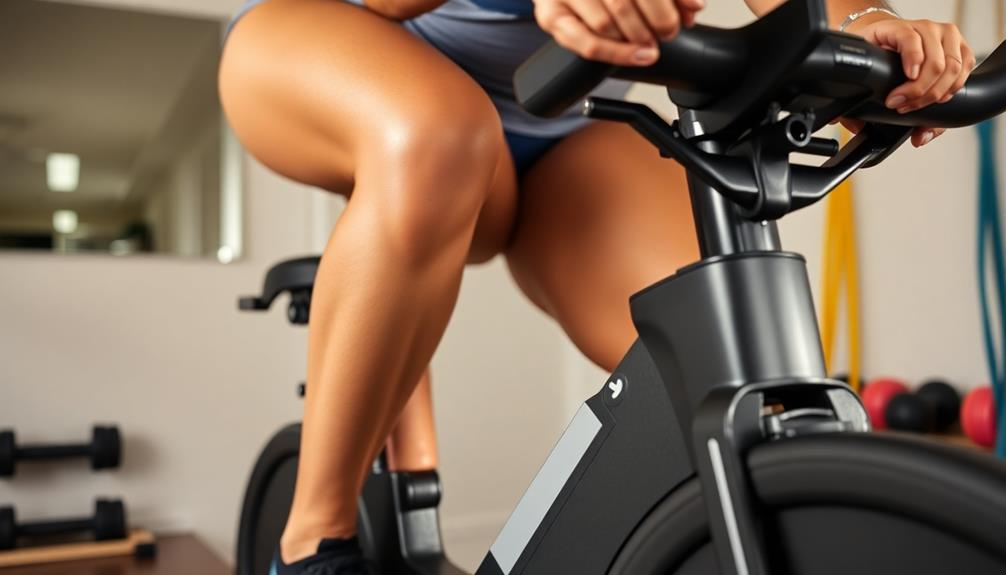Exercise bikes build muscle through targeted resistance training and high-intensity interval workouts. They engage multiple muscle groups, including quads, hamstrings, calves, and glutes. By gradually increasing resistance or workout duration, you'll stimulate muscle growth and improve strength. Proper form is essential: adjust your seat height, maintain good posture, and focus on both pushing and pulling the pedals. Vary your workouts to prevent muscle adaptation and incorporate progressive overload by slowly increasing intensity over time. Remember to fuel your body with proper nutrition and allow for adequate recovery between sessions. There's more to learn about maximizing your muscle-building potential on an exercise bike.
Core Insight
- Exercise bikes target multiple muscle groups, including quads, hamstrings, calves, glutes, and core.
- Progressive overload through increasing resistance, duration, or speed gradually builds muscle over time.
- High-intensity interval training (HIIT) on exercise bikes effectively breaks down and rebuilds muscle tissue.
- Varying workout routines and positions prevents muscle adaptation and promotes continuous growth.
- Proper form and technique, including correct seat height and pedaling motion, maximize muscle engagement and development.
Muscle Groups Targeted

Riding an exercise bike works many muscles in your body, not just your legs. Your quads, hamstrings, and calves do most of the work, pushing the pedals around. Your glutes also get a good workout, especially when you turn up the resistance or stand on the pedals. Using a foam roller after cycling can help your muscles recover.
Your core muscles, including your abs and lower back, work to keep you balanced and sitting up straight. Your upper body gets involved too. Your biceps and triceps support your upper body, while your shoulders and back help you maintain good posture. By changing your riding position and the resistance level, you can focus on different muscle groups.
Resistance Training Principles
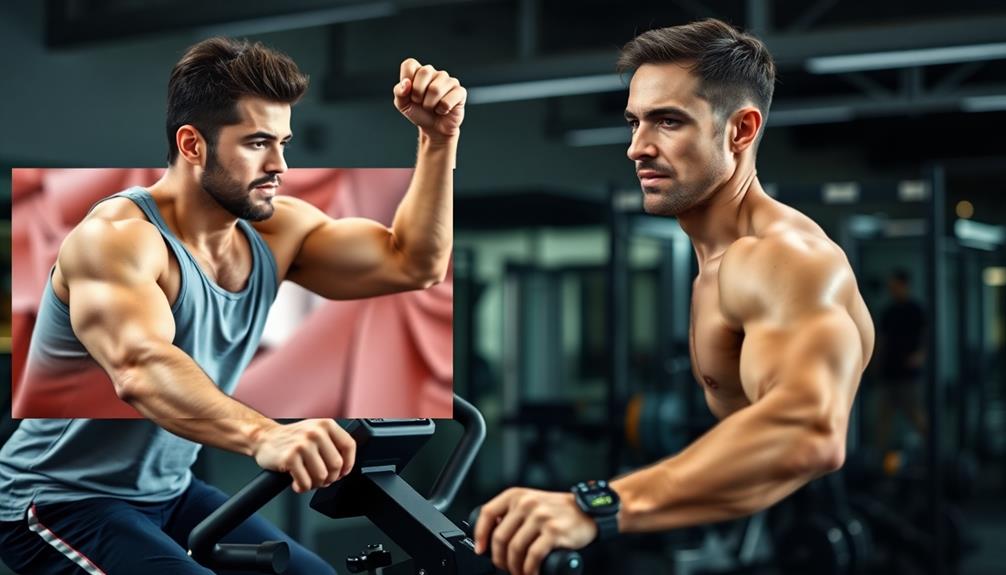
Several key principles apply when using an exercise bike to build muscle. First, you need to gradually increase the resistance or duration of your workouts. This challenges your muscles and helps them grow. It's also important to exercise regularly to keep your muscles stimulated.
To build the most muscle, try high-intensity interval training (HIIT) on your exercise bike. Vary your workouts so your muscles don't get used to the same thing. Allow time to recover between workouts, as this is when muscles grow.
Use proper form to fully work your muscles and avoid injury. Keep your abs tight, sit up straight, and pedal smoothly. Combine bike workouts with a healthy diet to support muscle growth and recovery.
High-Intensity Interval Workouts
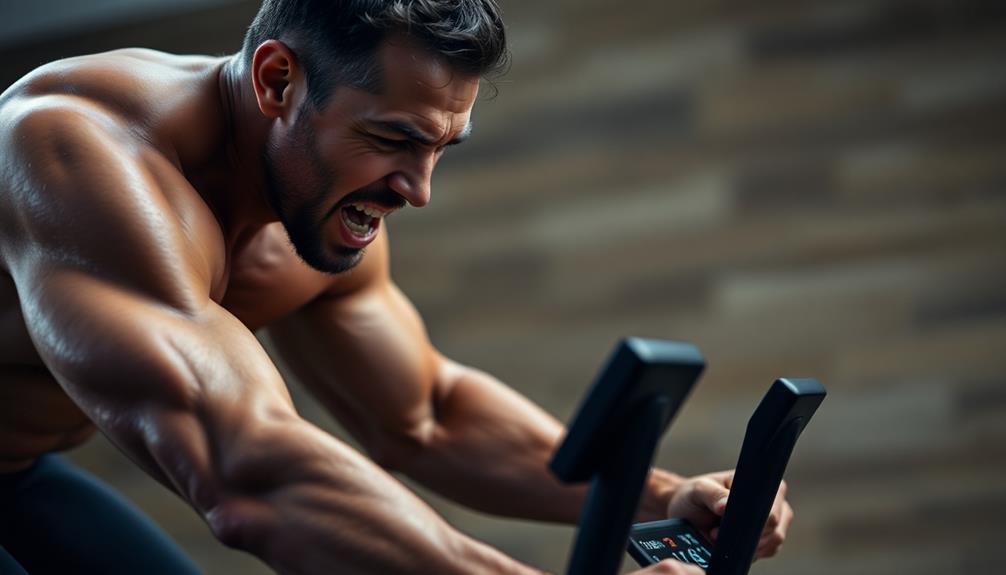
High-intensity interval training (HIIT) on an exercise bike is a great way to build muscle. HIIT alternates between short bursts of intense activity and brief recovery periods. During the work intervals, you'll pedal hard and fast. Then, you'll slow down to recover. HIIT can help break down muscle tissue and improve blood flow, just like certain massage techniques. This helps your muscles grow and stay healthy.
HIIT on an exercise bike has several benefits for building muscle:
- It makes your muscle fibers work harder
- It stresses your muscles in a good way
- It helps your body use insulin better
To start doing HIIT on an exercise bike, warm up for 5 minutes at a medium pace. Then, alternate between 30 seconds of fast pedaling and 30 seconds of slow pedaling for 15-20 minutes. Cool down for 5 minutes at the end. As you get better, you can change the work and rest times and make your HIIT sessions longer.
Progressive Overload on Bikes
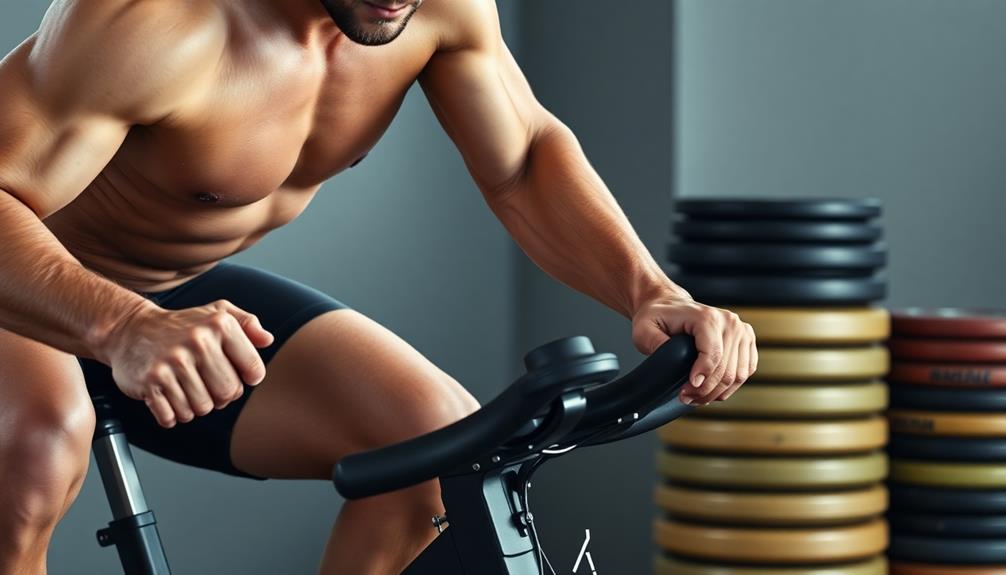
Progressive overload is an important concept for building muscle with exercise bikes. It means slowly making your workouts harder over time. On a bike, you do this by turning up the resistance or pedaling for longer.
To get started, figure out a resistance level and workout length you can handle. Then, each week, make a small increase. For example, add 5 minutes or go up one resistance level.
You can also use your pedaling speed to make progress. Try to pedal faster for longer periods as you get stronger. But don't overdo it – your body needs time to adapt. Small, steady increases will help you build muscle safely.
Proper Form and Technique
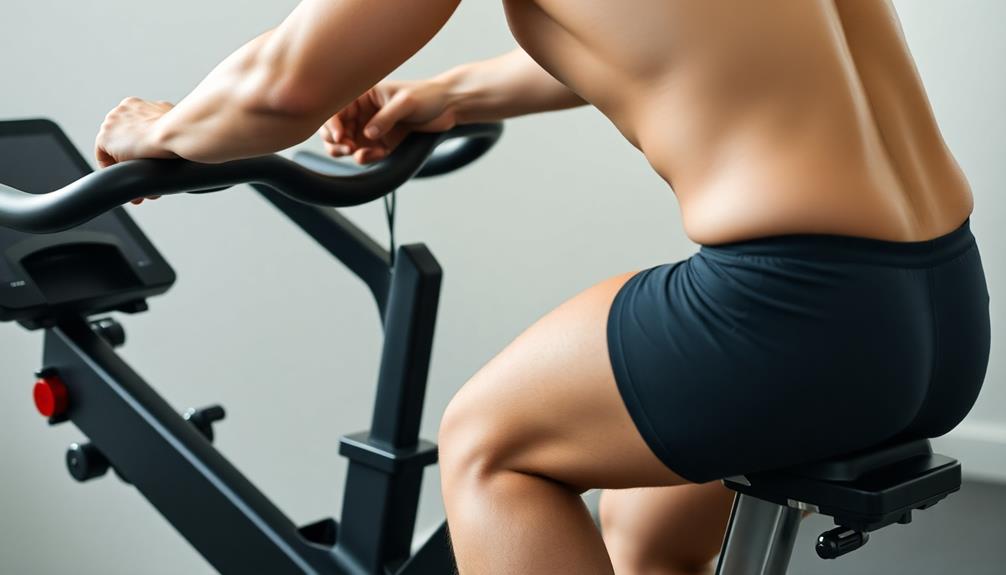
Proper form is key when using an exercise bike to build muscle. Focus on your posture, seat height, and pedaling to get the most out of your workout and avoid injury. Adjust your seat so your knee is slightly bent at the bottom of each pedal stroke. Cooling towels can help you stay comfortable during intense rides and maintain good form.
While cycling, remember to:
- Keep your core tight for a stable upper body
- Push and pull the pedals to work your quads and hamstrings
- Relax your shoulders and keep elbows slightly bent
Pedal at a steady speed and resistance throughout your workout. As you get used to proper form, slowly make your rides longer and harder. This builds muscle better and safely.
Nutrition for Muscle Growth
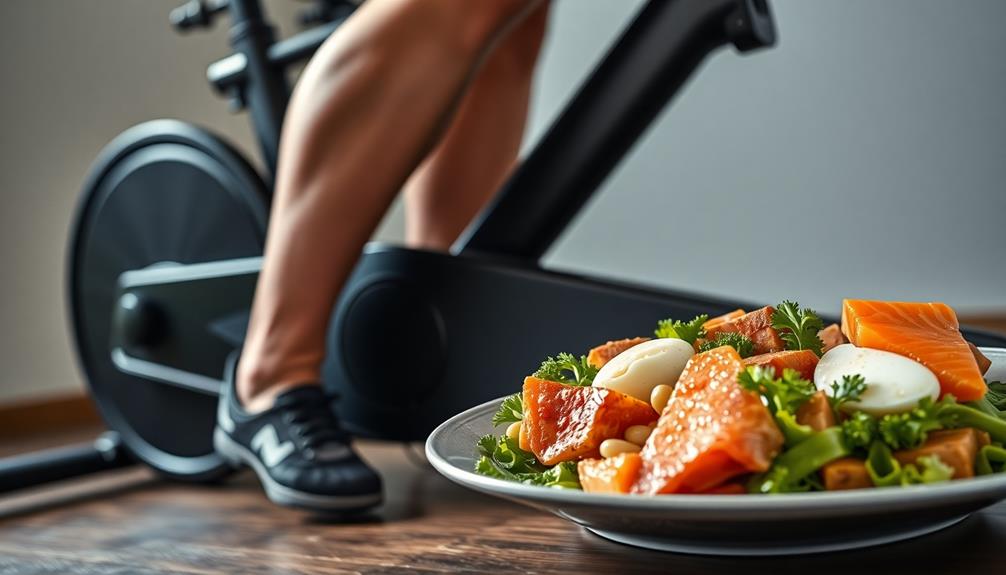
Eating right is just as important as proper form on your exercise bike if you want to build muscle. To get the most out of your cycling workouts, make sure you're getting enough protein. Aim for 1.6 to 2.2 grams per kilogram of body weight each day. Lean meats, fish, eggs, beans, and tofu are all great protein sources. Protein shakes can help you hit your daily protein target, especially when you're busy or need a quick snack after your workout.
Carbohydrates give you energy for exercise, so include plenty of whole grains, fruits, and veggies in your diet. Healthy fats from foods like avocados, nuts, and olive oil are also essential for overall health and hormone production.
When you eat is important too. Have a meal with protein and carbs within an hour after cycling to help your muscles recover and grow.
Recovery and Rest Periods

Recovery and rest are essential for building muscle when using an exercise bike. Your muscles need time to heal and grow after tough workouts. To get the most muscle gains, take rest days between cycling sessions and get enough sleep each night. Foam rollers can help with muscle soreness and flexibility during recovery. They work well for reaching tight spots and improving blood flow.
When recovering, remember to:
- Stretch and use a foam roller to reduce soreness
- Drink plenty of water to help muscles repair
- Eat foods high in protein to rebuild muscle
Combining With Strength Training
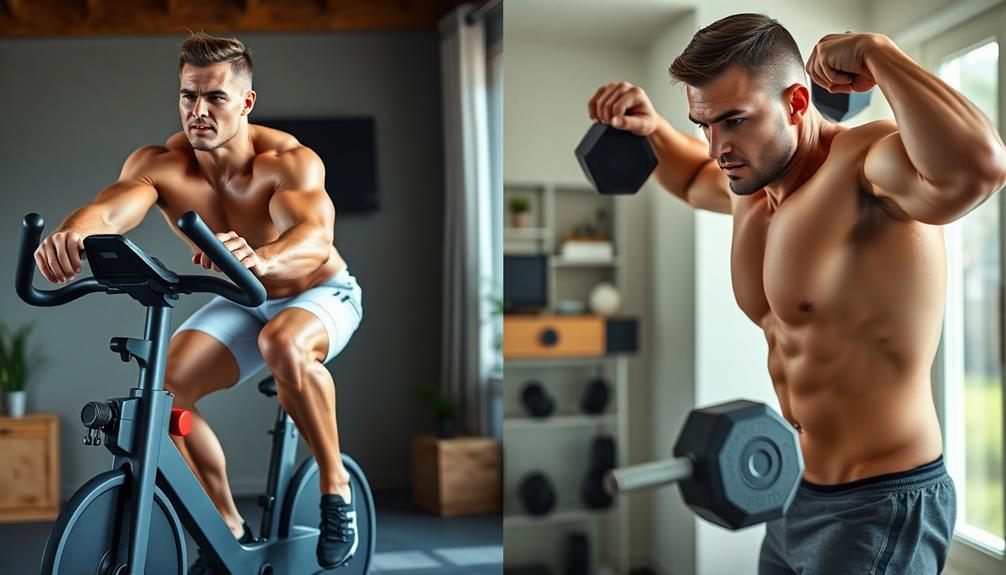
Combining exercise bike workouts with strength training is a great way to build muscle effectively. Along with cycling, do resistance exercises that work muscles not used much during riding. Squats, deadlifts, and lunges are good compound movements to include. Taking supplements like HMB capsules can also help support muscle growth.
Try cycling on some days and strength training on others so your body has time to recover. You can also do short resistance workouts before or after bike sessions. This helps keep your muscles balanced and prevents overuse injuries.
As you combine workouts, make sure to eat right. Get enough protein for muscle growth and carbs for energy. Drink plenty of water and take extra rest if your body needs it. Adding strength moves to your cycling routine will help you build muscle and get fitter overall.
Frequently Asked Questions
Can You Build Upper Body Muscles Using an Exercise Bike?
You won't build significant upper body muscles using an exercise bike. It's primarily a lower body workout. To target your upper body, you'll need to incorporate other exercises like push-ups, pull-ups, or weightlifting into your routine.
How Long Does It Take to See Muscle Growth From Cycling?
You'll typically notice muscle growth from cycling within 4-8 weeks of consistent training. However, it's important to remember that results vary based on your intensity, frequency, diet, and individual body composition. Keep at it and you'll see progress!
Are Exercise Bikes Suitable for People With Joint Problems or Injuries?
Exercise bikes are often suitable for those with joint issues or injuries. You'll find they provide low-impact workouts that don't strain your joints. They're adjustable, allowing you to customize your position for comfort and safety.
Do Recumbent Bikes Build Muscle as Effectively as Upright Bikes?
You'll find that recumbent bikes can build muscle, but they're not as effective as upright bikes. They primarily target your lower body, while upright bikes engage more core muscles and allow for greater intensity in workouts.
Can Exercise Bikes Help Reduce Cellulite While Building Muscle?
Yes, exercise bikes can help reduce cellulite while building muscle. You'll burn fat, improve circulation, and tone leg muscles. Consistent cycling workouts, combined with a healthy diet, can diminish the appearance of cellulite over time.

